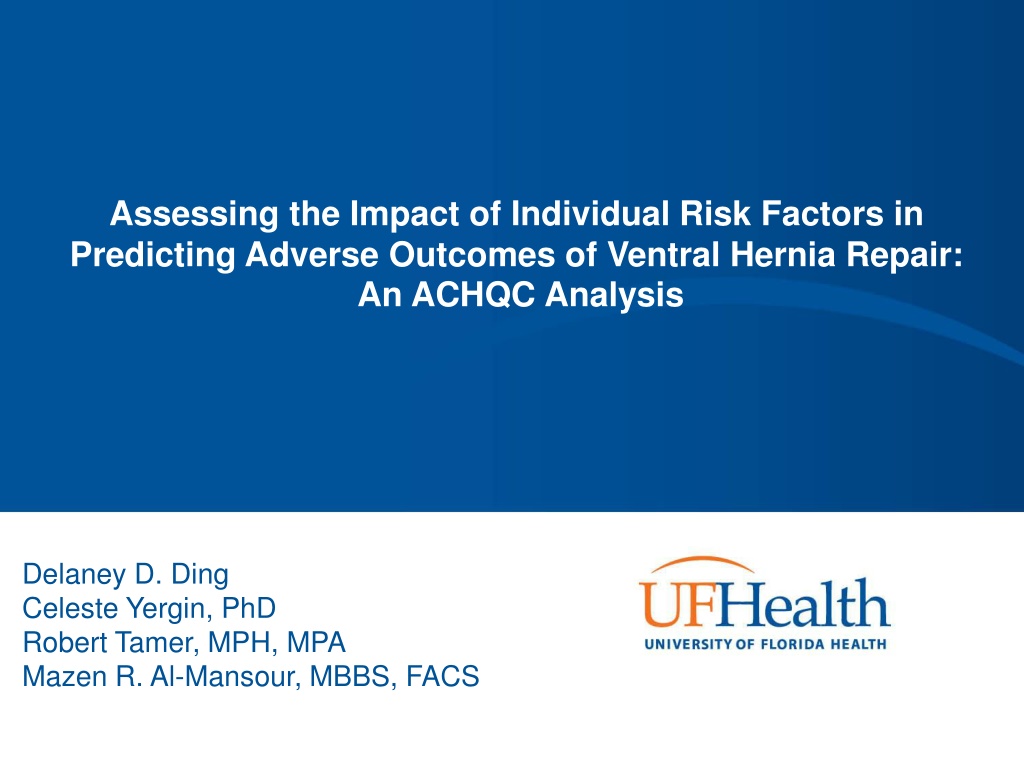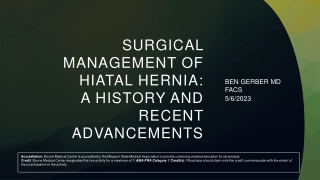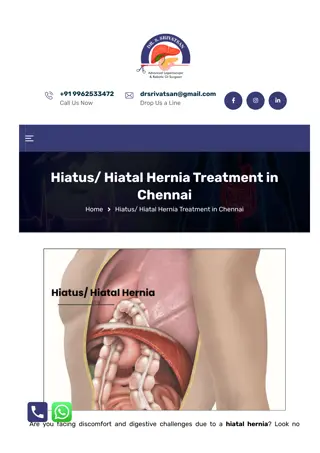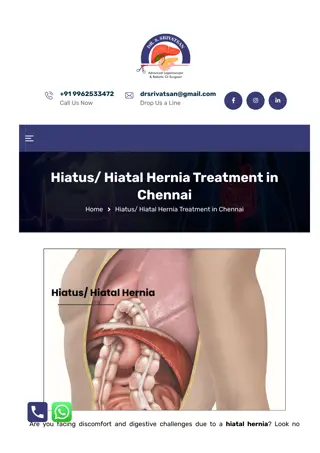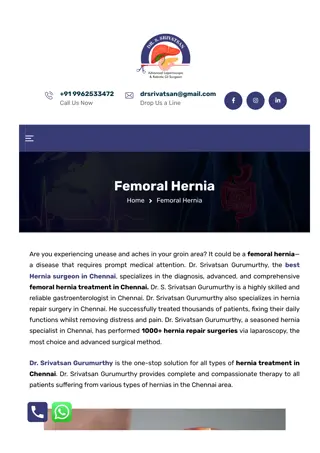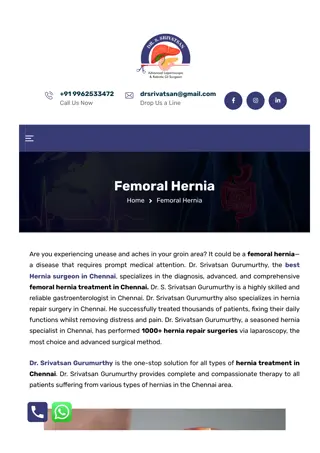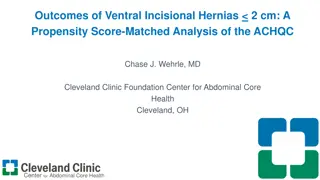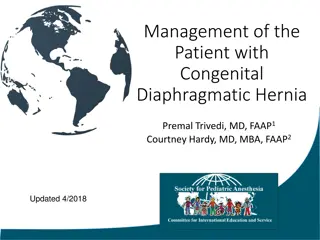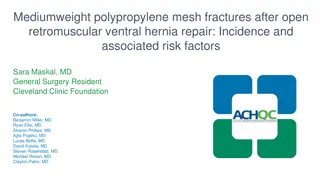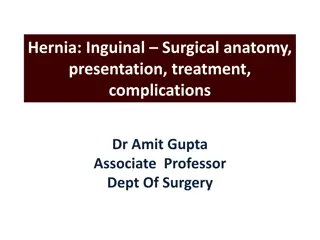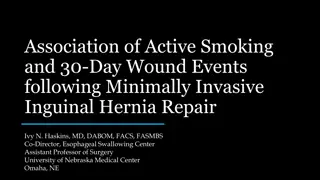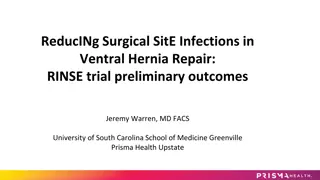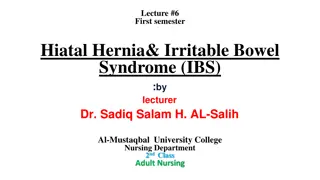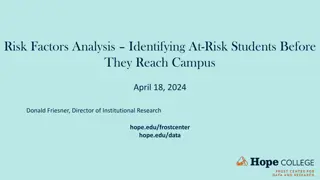Analysis of Individual Risk Factors in Ventral Hernia Repair Outcomes
This study explores the impact of various risk factors on predicting adverse outcomes of ventral hernia repair using data from the Abdominal Core Health Quality Collaborative (ACHQC). The research aims to quantify and compare the influence of different factors, hypothesizing that hernia- and procedure-specific factors are more predictive than patient-specific factors. Detailed analyses of patient and hernia characteristics, operative details, and methodologies are presented, shedding light on the complexities surrounding surgical outcomes in elective ventral hernia repair.
- Ventral Hernia Repair
- Risk Factors
- Surgical Outcomes
- Abdominal Core Health Quality Collaborative
- Research Analysis
Download Presentation

Please find below an Image/Link to download the presentation.
The content on the website is provided AS IS for your information and personal use only. It may not be sold, licensed, or shared on other websites without obtaining consent from the author. Download presentation by click this link. If you encounter any issues during the download, it is possible that the publisher has removed the file from their server.
E N D
Presentation Transcript
Assessing the Impact of Individual Risk Factors in Predicting Adverse Outcomes of Ventral Hernia Repair: An ACHQC Analysis Delaney D. Ding Celeste Yergin, PhD Robert Tamer, MPH, MPA Mazen R. Al-Mansour, MBBS, FACS
Disclosures This work was supported by the 2022 Resident and Fellow Research Grant from the Abdominal Core Health Quality Collaborative (ACHQC)
Background Patient Ventral hernia repair (VHR) complication risk factors Hernia Procedural
Aim and Hypothesis Quantify and compare the influence of numerous risk factors on VHR complications for ACHQC patients We hypothesize that hernia- and procedure-specific factors are more predictive of surgical outcomes compared to patient-specific risk factors.
Methods Ret Area Under Curve (AUC) Adults, Elective VHR, 30-day follow-up completed Primary outcome: overall 30-day postoperative complications Area under the curve (AUC) of the receiver operator curve
Patient characteristics Elective VHR (n=35,108) Age, median (IQR) year 57 (46, 67) Male, n (%) 18,524 (53) BMI, median (IQR) kg/m2* 31 (27,36) ASA class, n (%) 1 2 3 4 5 3,062 (10) 15,083 (43) 16,098 (46) 716 (2) 5 (0.0)
Hernia characteristics Elective VHR (n=35,108) 9,097 (26) Recurrent hernia, n (%) Ventral hernia type, n (%) Incisional Parastomal Epigastric Umbilical Other (Spigelian, Lumbar, Diastasis Recti) 21,353 (61) 1,723 (5) 2,412 (7) 10,069 (29) 826 (2) Hernia width, median (IQR) cm 4 (2,9) Hernia length, median (IQR) cm 5 (2,15)
Operative Details Elective VHR (n=35,108) Clean, n (%) 30,985 (88) Open, n (%) 21,998 (64) Myofascial release, n (%) 11,813 (35) Mesh position, n (%) Inlay Onlay Sublay intraperitoneal 806 (3) 1,814 (6) 8,927 (31) 5,981 (21) 11,493 (40) Sublay preperitoneal Sublay retromuscular Surgeon affiliation, n (%) Academic Private Private with academic affiliation 22,290 (64) 8,665 (25) 4,144 (12)
Results Elective VHR (n=35,108) Complications, n (%) 5,611 (16) Wound complications, n (%) Surgical site infection Surgical site occurrence (SSO) SSO requiring procedural intervention 988 (3) 2,850 (8) 1,333 (4) Readmission, n (%) 1,245 (4) Reoperation, n (%) 488 (1) Mortality, n (%) 50 (0.0)
Results AUC 0.60: Defect width Defect length Drain use Myofascial Release ASA class Mesh position Incisional hernia
Conclusions Most individual risk factors were poorly associated with VHR complications Assessment of VHR complication risk should not rely on a single risk factor
Limitations Sampling bias ACHQC is designed to measure outcomes of VHR, but not watchful waiting Long-term outcomes (e.g. recurrence) were not evaluated
Acknowledgments Co-authors Dr. Celeste Yergin Robert Tamer Dr. Mazen Al-Mansour (#Mentor) ACHQC
